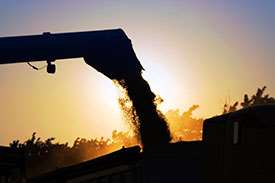By Tracy Turner

Lower crop prices this year combined with higher input costs means that producers, farmers and farm business owners may need to develop clear financial strategies to deal with projected lower profit margins, says a farm business expert with the College of Food, Agricultural, and Environmental Sciences at The Ohio State University.
In order for farmers to lessen the potential for losses and to deal with the prospect of lower profitability, they first must fully understand where they are financially, said Chris Bruynis, an Ohio State Extension educator. OSU Extension is the outreach arm of the college.
“Questions to consider include, can you restructure debt, reduce costs or even switch to more profitable crops,” he said. “Farmers are going to have to constantly evaluate their financial management decisions in order to get through these tighter economic times.”
Bruynis will address the issues producers should consider when evaluating their financial health at the college’s Farm Science Review during the “Ask the Experts” question-and-answer sessions on Sept. 21 from 11:20 to 11:40 a.m. and Sept. 22 from 10:20 to 10:40 a.m. Ask the Experts is offered daily at the Review, Sept. 20-22, at the Molly Caren Agricultural Center near London, Ohio.
The Review offers farmers and other visitors the opportunity to learn about the latest agricultural innovations from experts from the college.
Some of the points Bruynis will discuss during the sessions include:
* Complete a financial analysis. Knowing where your business stands financially is critical in developing a plan to survive this period of low margins. Good financial capacity allows farm families to borrow new money, restructure term debt, or even make interest-only payments on some loans.
* Lower the cost of production. There is significant variation among farmers in the cost of production depending on size and scale of the operation. Items such as cash rent, input costs, operating costs and equipment depreciation can greatly affect this cost. Strategies to lower input costs can include setting realistic yield goals and adjusting your inputs accordingly, selecting lower priced inputs providing they perform similarly, and making sure the input generates more than its cost.
* Improve grain-marketing skills. Grain marketing strategies vary somewhat depending on on-farm storage, crop insurance participation and total bushels available for sale. Regardless of the farm constraints, it is critical to set price targets that are realistic and based on the farm’s true cost of production. Also, it’s important to be able to use available marketing tools such as option contracts and hedge-to-arrive contracts and understand risk exposure created or protected by each.
* Increase profitable enterprises. Farmers will need to closely evaluate the possibility of increasing acres of one crop over another. Farmers may also wish to adopt a different cropping strategy such as double cropping to maintain profitable income levels. Be careful not to exchange short-term profitability over long-term profitability.
* Reduce unproductive assets. Growing crops on marginal soils or rented ground with extremely high rental rates may be good candidates for removal from the business portfolio. Farmers need to weigh the loss from farming these properties compared to the fixed costs that will be spread over the remaining acres to determine if this is a good decision. Other ideas could include selling unused and underutilized equipment on the farm.
* Add additional revenue streams. Additional revenue streams can come from a few sources, but most commonly this would be the addition of off-farm employment for one or more of the adult family members. Other ideas would be the addition of other agricultural production enterprises or agritourism enterprises.
* Talk to your lender. The earlier you communicate with your lender, the more options will be available to you. Bankruptcy auctions rarely provide the cash flow needed to repay farm loans and meet other financial obligations of the farm family.
* Cooperation among neighbors. Producer may want to consider creating farming arrangements that include bulk purchasing of inputs, owning equipment and producing greater marketing opportunities to maximize income. The arrangements could involve farmers specializing in a farming practice such as planting, spraying and harvesting and working together to capitalize on the specialized strengths of each other.
* Work toward full employment. This can include adding enterprises to their business portfolio and hiring labor more fully. Examples include excavating, construction and painting businesses, or livestock, machine shop and custom hire enterprises.
* Know if or when it is time to get out. Farm business owners need to assess when exiting the business may be the best alternative for them. At some point, preserving wealth should become more important than continuing against all odds. This might look very different for someone who is 35 than someone 65 years old.
The low profitability session is just one of multiple presentations that will be offered during “Ask the Experts” at the Review. Some of the other topics include:
* Grain market update.
* Ohio cropland values and cash rents.
* Avian influenza.
* Working capital on Ohio farms.
* Busting the myths of GMOs.
* Spread of Zika and other diseases.
* Veterinary feed directive.
* Antimicrobial use and resistance.
* Flying legal under the new drone laws.
* Drinking raw milk.
* Liquidity and risk management: Facts everyone should know.
Sponsored by CFAES, the Review offers visitors some 180 educational presentations and opportunities presented by educators, specialists and faculty from OSU Extension and the Ohio Agricultural Research and Development Center, which are the outreach and research arms, respectively, of the college.
Source:purdue.edu